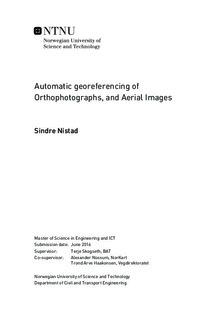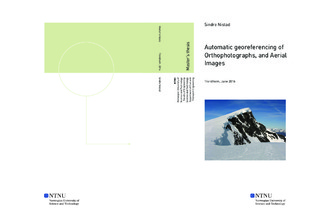| dc.description.abstract | With the advent of drones, the need for rapid, and accurate georeferencing of orthophotos is expected to grow. Per now (June 2016) there are no commercial solutions that is capable of automatically georeference an orthophoto to a set of ground control points. Some semi-automatic solutions exist, but these rely on user interaction, or on having an already georeferenced orthophoto, which will then be matched to the desired orthophoto.
A prototype for such a fully automatic system has been developed as part of this Master s thesis to investigate the possibility, and feasibility of automatic georeferencing of orthophotos, aerial images, with or without a digital elevation model.
By applying the prototype to a orthophoto with a corresponding surface model over Lerkendal, Trondheim, Norway, the program was able to calculate the absolute orientation, and georeference the orthophoto in less than 7 minutes. The root mean square error for the location (Northing-Easting) was as small as 0.0738 meters. Unfortunately, the elevation was not as good (0.847 meters). If the main purpose of georeferencing the data is to only have a referenced orthophoto, this prototype comparable with manual referencing in terms of accuracy, and can be even faster than the manual approach.
The prototype, and it source code is freely available at https://github.com/cLupus/AutoRef, and a binary distribution is available at https://server.nistad.me/AutoRef/bin/main/. The source code is licensed under the Mozilla Public License 2.0, which mean you are free to use, modify and distribute all, or part of the source code.
During development, the concept, and algorithm of topological point patterns from Li and Briggs (2006) was adapted to investigate whether it could be used in a different context. It could. However, some faults were found in the presented algorithm. The faults were fixed, and an implementation is given.
Part of this thesis investigate different algorithms for finding the optimal absolute orientation parameters, in a least-squares error sense. Between the method presented in Horn (1987), and Horn et.al. (1988) the difference in root mean square error, and parameters for the absolute orientation was rather small. Umeyama (1991) presents a different algorithm, which is also claimed to be optimal. In particular, the scaling factor presented in the article is claimed to give the minimal root mean square error. However, this is proven to be a false statement in this thesis. The proposed scale factor is sub-optimal compared to using the scale factor proposed in Horn (1987), when everything else is the same. | |

